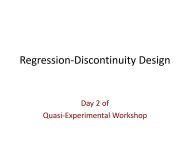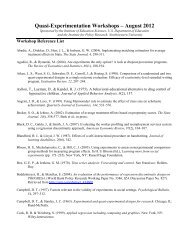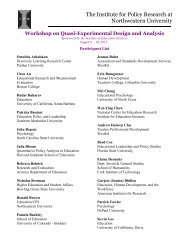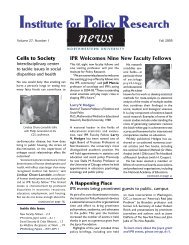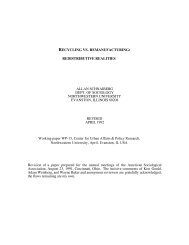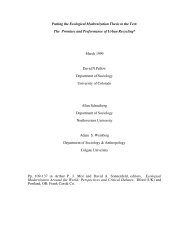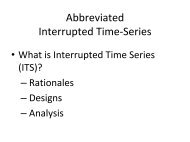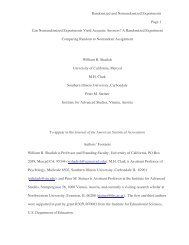pdf - Institute for Policy Research - Northwestern University
pdf - Institute for Policy Research - Northwestern University
pdf - Institute for Policy Research - Northwestern University
Create successful ePaper yourself
Turn your PDF publications into a flip-book with our unique Google optimized e-Paper software.
J. Reblando<br />
Earlier studies of Gautreaux I families<br />
by Rosenbaum and others showed<br />
better outcomes <strong>for</strong> children—such as<br />
improved school per<strong>for</strong>mance, attending<br />
better colleges, and better employment<br />
opportunities. Un<strong>for</strong>tunately, preliminary<br />
results <strong>for</strong> Gautreaux II families, who<br />
moved between 2002 and 2003, have<br />
not been as promising. When moving a<br />
second time, Gautreaux II families ended<br />
up in neighborhoods with higher rates<br />
of poverty and percentages of African<br />
Americans than Gautreaux I families.<br />
Duncan notes the subsequent moves<br />
seemed to undo the benefits of the initial<br />
move in Gautreaux II.<br />
In between Gautreaux I and II came<br />
MTO, a random-assignment program<br />
implemented in five major U.S. cities.<br />
It studied a treatment group offered<br />
assistance to move to more affluent<br />
neighborhoods and a control group<br />
not offered such assistance. The<br />
MTO program mandated destination<br />
neighborhoods with poverty rates of 10<br />
percent or less, while Gautreaux I only<br />
targeted race and Gautreaux II set criteria<br />
<strong>for</strong> both race and poverty. According to<br />
Duncan, MTO’s most striking success<br />
has been a sharp improvement in the<br />
mental health of the mothers who<br />
moved, with cases of depression being cut<br />
in half. Mothers cited getting away from<br />
gang- and drug-ridden neighborhoods as<br />
their No. 1 reason <strong>for</strong> moving.<br />
However, evaluators found that children<br />
of MTO participants still attended<br />
underper<strong>for</strong>ming schools, though these<br />
were somewhat higher-achieving schools<br />
than be<strong>for</strong>e. Participants also did not<br />
experience higher employment, nor less<br />
welfare receipt, when compared with<br />
the control group—though the control<br />
group set a high standard as it doubled<br />
its employment rate in the late 1990s.<br />
Rosenbaum explained this might also be<br />
due to the fact that when MTO families<br />
changed neighborhoods, most moved less<br />
than 10 miles away—compared with an<br />
average of 25 miles <strong>for</strong> the Gautreaux<br />
participants. This allowed some MTO<br />
families to move to highly segregated<br />
neighborhoods or keep their children in<br />
the same schools.<br />
Duncan is currently co-principal<br />
investigator of a $10 million ef<strong>for</strong>t to<br />
re-interview adults and children in a<br />
10-year follow-up to the Moving to<br />
Opportunity program. Duncan and his<br />
colleagues received $1.8 million to study<br />
the long-term effects of neighborhoods<br />
on low-income youth. The grant is<br />
part of the John D. and Catherine T.<br />
MacArthur Foundation’s recent $25<br />
million investment in housing research.<br />
The researchers propose to collect new<br />
data on 2,444 youth, now 10 to 14 years<br />
old, who were newborns to 5-year-olds<br />
at the time of random assignment. As<br />
recent child development findings suggest,<br />
this group might be the most susceptible<br />
to environmental changes. They will<br />
investigate the children’s education,<br />
mental and physical health, and<br />
delinquent, risky, or problem behavior.<br />
The researchers will also interweave the<br />
MTO data with school records, arrest<br />
histories, and possibly biomarker data <strong>for</strong><br />
health in<strong>for</strong>mation.<br />
Gentrification and Chicago’s Black<br />
Middle Class<br />
Sociologist Mary Pattillo’s latest book,<br />
Black on the Block: The Politics of Race<br />
and Class in the City (<strong>University</strong> of<br />
Chicago Press) focuses on gentrification<br />
and public housing construction in<br />
the North Kenwood/Oakland (NKO)<br />
area. NKO is a neighborhood on<br />
Chicago’s south lakefront that has<br />
been predominantly African American<br />
since the 1950s and is currently facing<br />
gentrification by the black middle<br />
class. The book highlights the black<br />
professionals’ crucial but often conflicted<br />
Stateway Gardens, a Chicago<br />
public housing development<br />
www.northwestern.edu/ipr 17



